
Ants
Ants are found anywhere. From inside and outside your home, to all countries around the globe.
Learn More About Ants
Ants, classified under the family Formicidae, are highly social insects known for their complex colony structures and ability to adapt to various environments, making them prevalent across the globe.
These insects are distinguished by their elbowed antennae, strong mandibles, and a segmented body that includes a distinct narrow waist. They range in size from about 0.08 to 1 inch. Ants are recognized for their remarkable organizational skills and collective work ethic, which allows them to build extensive nests, gather resources, and defend their colonies efficiently. Some ants can sting and bite which can be very painful and in some cases cause allergic reactions.
Ants are scavengers and can contaminate food as they forage. They can carry bacteria and other pathogens from their environment into homes, potentially spreading diseases such as Salmonella.
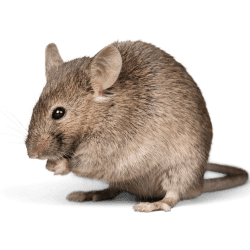
Mice
Mice are one of the most destructive and smartest pests out there. A real challenge for every home owner.
Learn More About Mice
Mice are mammals that belong to the Muridae family and they are small, adaptable rodents found almost everywhere in the world, making them one of the most common pests in homes and businesses. Characterized by their pointed snouts, large rounded ears, and long, thin tails, mice typically measure about 3 to 4 inches long, excluding the tail.
These creatures are known for their quick breeding, with a single pair capable of producing a large population in a short time. Mice are omnivorous scavengers but primarily feed on grains and fruits, often leading them to raid human food supplies. Their need to gnaw to keep their constantly growing teeth at a manageable length means they can cause significant damage to furniture, structures, and wiring, potentially leading to electrical fires. Moreover, mice can carry a variety of pathogens that can spread diseases such as salmonella and hantavirus to humans through their droppings, urine, or saliva.
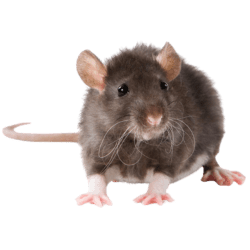
Rats
Rats have their neverending chewing abilities that can lead to major damage in homes.
Learn More About Rats
Rats, Part of the Muridae family, are robust rodents known for their adaptability and intelligence, making them widespread across various environments globally. They typically feature large bodies, sharp incisors, and long tails, with common species measuring up to 9 inches in body length. Rats are notorious for their rapid reproduction rates and their ability to survive in diverse and challenging conditions.
As omnivores, they have a varied diet but often seek out grains, fruits, seeds, and proteins, frequently invading human spaces in search of food. The structural damage from rats can be extensive, as they gnaw through materials like wood, plastic, and even mild steel to maintain their tooth length. Furthermore, rats are vectors for numerous pathogens and can transmit diseases such as leptospirosis, tularemia, and the bubonic plague. Their presence can also lead to secondary infestations of pests like fleas.
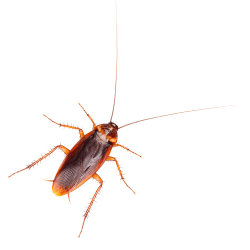
Cockroaches
Cockroaches are a nightmare to any home owner. They are mostly found in warm spaces.
Learn More About Cockroaches
Cockroaches, Belonging to the family Blattida and order Blottodea, are one of the oldest and most resilient insects, known for their adaptability in various environments but typically thriving in warm, moist conditions typical of human habitats. They have flat ovular bodies, small heads, six legs, compound eyes, and long antennae. Cockroaches can spread diseases such as salmonella and dysentery by carrying pathogens on their bodies, and their droppings, skin shedding, and saliva can trigger allergies and asthma.
Remarkably, Cockroaches can survive up to a week without their head, run up to 3 miles per hour, and handle 10 times the radiation humans can.

Scorpions
Their stingers and pincers give scorpions an aggressive appearance that scare most people.
Learn More About Scorpions
Scorpions, part of the class Arachnida and order Scorpiones, are predatory arachnids known for their venomous sting. Recognizable by their segmented tails with a stinger and grasping pincers, scorpions vary in size from about 1 to over 7 inches.
These nocturnal creatures usually inhabit dry, arid, or tropical environments, hiding under rocks or inside homes during the day.
They primarily feed on insects, spiders, and sometimes small mammals, using their venom to immobilize their prey. While most scorpions’ venom causes only midland symptoms in humans, like pain and irritation, some species can inflict more severe effects.
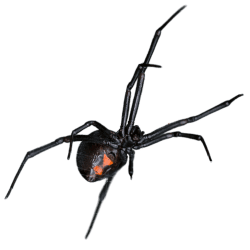
Black Widow Spiders
One of the most feared spiders in the world is the Black Widow Spider, with a venom 15x stronger than a Rattlesnake.
Learn More About Black Widow Spiders
The Black Widow Spider, scientifically known as Latrodectus mactans, is a highly venomous species found predominantly in the temperate regions of the United States. Recognizable by the glossy black color and the distinctive red hourglass marking on the underside of its abdomen, Blackwidows are small, with females measuring about 1.5 inches including leg span, and males significantly smaller.
Black Widow spiders are notorious for their potent venom, which is considered more dangerous than that of a rattlesnake, gram for gram. The venom can cause severe pain and muscle cramps in humans, and while bites are rarely fatal, they can pose serious health risks, especially to young children and the elderly.
These spiders are solitary except during mating, often residing in dark, undisturbed areas such as sheds, garages, and beneath stones and woodpiles. Females can be aggressive if they perceive a threat, especially after laying eggs.
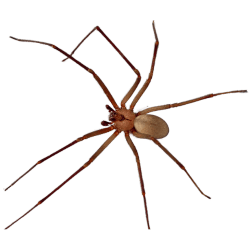
Brown Recluse Spider
These spiders aren’t quite as dangerous as Black widows, but have a dangerous bite, especially in children and elderly.
Learn More About Brown Recluse Spiders
The Brown Recluse spider, scientifically known as Lexosceles recluse, is a venomous spider known for its distinctive violin-shaped marking on its cephalothorax, pointing towards its abdomen. Typically light to dark brown, these spiders are small to medium-sized, with body lengths ranging from about 0.25 to 0.75 inches, excluding leg span.
Brown recluse spiders are infamous for their necrotic venom. Bites are often not felt initially but can develop into serious wounds that are slow to heal and may require medical attention.
These spiders are reclusive by nature, preferring undisturbed areas such as closets, attics, basements, and behind furniture. They are non-aggressive and typically bite only when threatened or pressed against human skin.
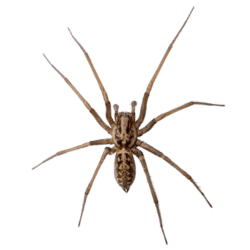
Hobo Spiders
These spiders are among the most commonly seen in homes. Their appearence drives chills and fear.
Learn More About Hobo Spiders
The Hobo Spider, scientifically known as Eratigena agrestis, is a member of the funnel-web spider family, Agelenidae, and is recognized by its distinct pattern of yellow markings on the brown body, with a herringbone or chevron pattern on its abdomen. Typically, these spiders range in size from 0.6 to 0.8 inches in body length, with a leg span of up to 2 inches.
Originally native to Europe, Hobo Spiders have become prevalent in the Pacific Northwestern United States. They are known for their funnel-shaped webs, which they construct in holes, cracks, and crevices near the ground, often within human habitats such as basements and window wells.
The venom of the Hobo Spider is believed to cause mild necrosis, although its effects have been the subject of debate and recent studies suggest it is less harmful to humans than previously thought. Symptoms of a bite might include redness, swelling, and mild pain, but are generally not severe.
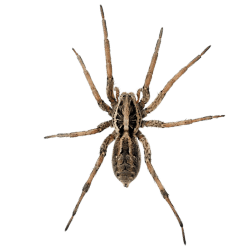
Wolf Spiders
The Wolf Spider is the 2nd most commonly seen spider in homes accorss the United States.
Learn More About Wolf Spiders
Wolf spiders, belonging to the family Lycosidae, are robust and agile hunters known for their excellent eyesight and fast movements. These spiders do not spin webs to catch prey; instead, they chase down or ambush their victims. Wolf spiders can vary greatly in size, with species measuring up to 1.5 inches in body length, not including leg span.
Characterized by their hairy bodies and a pattern of stripes or markings that usually includes a Union Jack impression on their back, Wolf spiders are predominantly brown or gray with camouflaging markings. These spiders are generally found on the ground in garden areas and under stones, leaves, and wood logs, but can venture into homes in search of prey.
Despite their fearsome appearance and name, wolf Spiders are not aggressive toward humans and will only bite if threatened or handled. The bite of a Wolf Spider is venomous but not lethal to humans, typically resulting in mind swelling, pain, and itching.

Termites
The amount of damage termites can cause makes them the most feared pest to have as a homeowner.
Learn More About Termites
Termites, belonging to the infraorder Isoptera, are social insects known for their wood-consuming habits, which can cause significant structural damage to homes and buildings. These insects are small, typically ranging from 0.25 to 0.5 inches in length, and are usually pale in color.
Termites are organized into castes with distinct roles: workers, soldiers, and reproductive individuals, including queens and kings. Termites feed on cellulose, primarily found in wood, but also in paper, cardboard, and other plant materials. This feeding can go unnoticed for long periods, allowing structural damage to become extensive before discovered. There are several species of termites, with the most common in the United States including the subterranean, drywood, and dampwood termites.
Subterranean termites, which build their nests underground, are the most destructive. They construct mud tubes to provide moisture while they travel between their colony and food sources. Drywood termites, on the other hand, live directly inside the wood they consume and do not require contact with the soil.

Mosquitoes
Mosquitoes are the most dangerous animals on the planet, killing 700,000 people worldwide, annually.
Learn More About Mosquitoes
Mosquitoes, from the family Culicidae, are small, flying insects known for their role as one of the world’s most notorious pests due to their ability to spread deadly diseases.
Typically measuring about 0.125 to 0.75 inches in length, these insects are easily recognizable by their long legs and proboscis, the elongated mouthpart used to pierce skin and feed on blood. Mosquitoes are vectors for numerous pathogens that cause diseases such as malaria, Zika virus, West Nile virus, dengue fever, and chikungunya, making them a major public health concern worldwide.
Only females require blood meals, which they use to develop their eggs, while both males and females feed on nectar and other plant sugars.
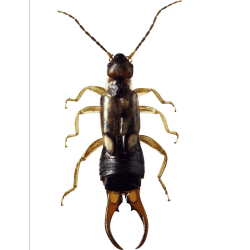
Earwigs
Earwigs are one of the most common pests in households across the United States.
Learn More About Earwigs
Earwigs are small to medium-sized insects from the order Dermaptera, easily recognized by their distinctive pincers (cerci) at the end of their abdomens.
Typically measuring about 5 to 25 millimeters in length, earwigs have elongated bodies and are usually dark brown to black. These nocturnal insects are mostly harmless to humans and are not known to spread any diseases.
Earwigs feed on a wide range of materials, including decaying plant matter and other insects, which can make them beneficial in gardens as natural pest controllers. However, they can become a nuisance if they invade homes, seeking moisture or shelter inside bathrooms, kitchens, or laundry rooms.

Wasps
Just about everyone has a bad experience with wasps! They are one of the worst pests to have around your home.
Learn More About Wasps
Wasps, belonging to the order Hymenoptera and family Vespidae, are known for their slender bodies and narrow waists. They range in size from about 0.5 to 1.5 inches in length and are typically yellow and black, although some species may have red, brown, or metallic blue colorations.
Wasps are beneficial as they prey on many pest insects, but they can become a nuisance or hazard when they nest near human activity. Wasps are social insects, with colonies that start anew each spring, initiated by a fertilized queen that survived the winter. These colonies can grow significantly through the summer and early autumn, often building paper-like nests out of chewed wood fibers mixed with saliva.
They are found in a variety of environments, from gardens and woodlands to human structures like eaves, attics, and the undersides of balconies. Unlike bees, wasps can be more aggressive and are capable of stinging multiple times. Their stings are painful and can trigger allergic reactions in sensitive individuals, ranging from mild irritation to severe anaphylactic shock.

Boxelder Bugs
Just when you think pests season is over these guys show up to invade your home every year.
Learn More About Boxelder Bugs
Boxelder bugs, scientifically known as Boisea Trivittata, are part of the Rhopalidae family. These bugs are most recognizable by their distinctive black and red or orange markings, Adults are about 0.5 inches long, with elongated, oval bodies that become more noticeable when they congregate in large numbers.
Primarily, boxelder bugs feed on the seeds and leaves of boxelder trees, as well as other maple and ash trees, from which they derive both their name and sustenance. They use their piercing mouthparts to suck nutrients from the tree, generally without causing significant damage.
However, their presence can become quite a nuisance, especially when they invade homes in search of a warm place to overwinter. During the fall, boxelder bugs start to cluster on the warm exteriors of buildings exposed to the sun and can enter homes through cracks and crevices in windows, doors, and foundations. While they are not harmful to humans and do not bite, their drippings can stain fabrics, walls, and floors.
ALL PEST CONTROL TREATMENTS $150 OFF
or call (888) 515-0111

4.9 Average | 1500+ Reviews
